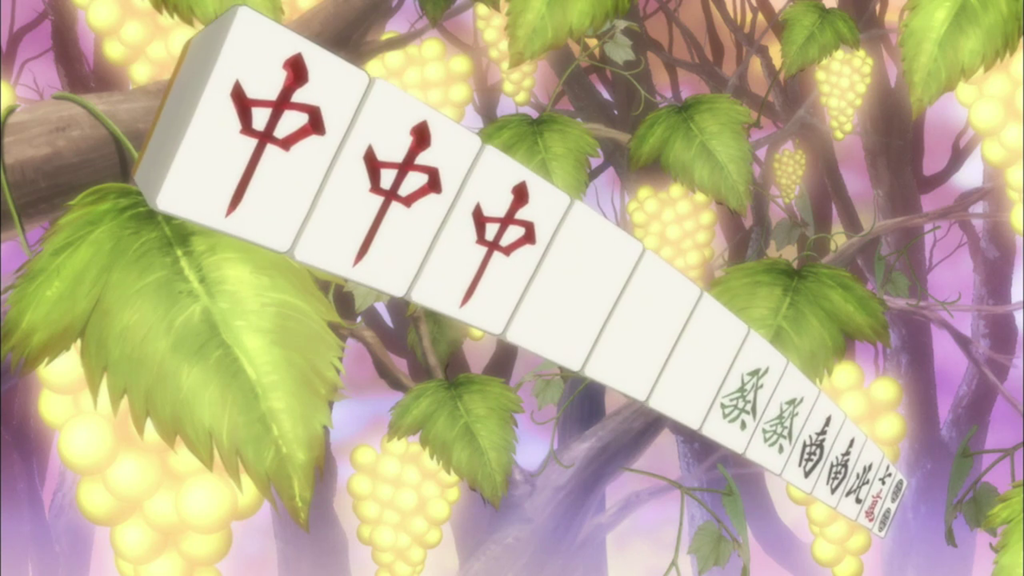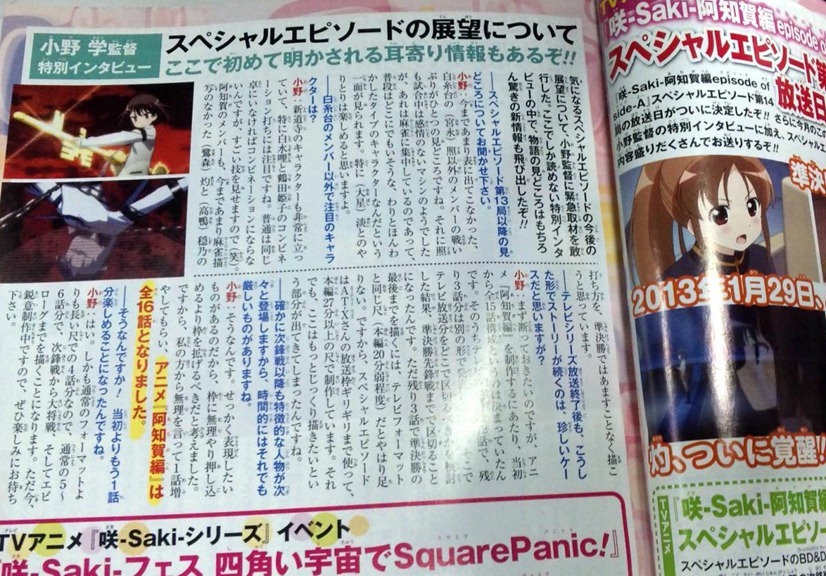
The 13th episode of Saki Achiga introduced us to two new abilities: Sumire’s [Sharpshooter] skill, which aligns her waits with a chosen victim’s predicted discards, and Takami’s [Harvest time], which lets her draw a hand composed of all her initial discards throughout the match in the very last dealing of the game.
Unlike Sumire’s ability, which is quite complex and requires the reader/viewer to make some additional assumptions about its mechanics, Takami’s ability is quite easy to replicate in real life. So how strong is it exactly? I played a few times Takami-style, giving myself 11 chances to collect discards (the same as in the Achiga match).

First attempt. With a near-guaranteed shousangen (two dragon triples and a dragon pair), and plenty of options leading to a honitsu (one color and honors), this hand should usually result in a haneman hand (12,000 points, or dealer 18,000). A daisangen yakuman (three dragon triplets) is entirely feasible under normal circumstances, but more risky.

Ugh. Trying to go for wind pairs/triplets left the hand crippled. The daisangen tiles are the same as above, but the odds of going out on this at all are very bad…

Lesson learned. The third attempt is just asking for a daisangen, with quick runs on the side.

See above, the fourth attempt can result in daisangen tenpai as fast as during the first go around. Terrifying.
To sum up, Takami’s ability:
- might sometimes result in a slow hand if the discards are not chosen carefully (but Takami probably has plenty of experience with her own ability)
- does reliably provide at least a shousangen hand almost every time, with other bonuses possible on the side
- makes the probability of a daisangen hand ridiculously high

But! (there is always a but, isn’t there?)
The make-or-break of this ability is whether your opponents know how it works. Attempt four above, which is an almost guaranteed yakuman under normal circumstances, becomes very tricky if your opponents know exactly what you have in hand. Though admittedly, going out with the hand still requires much less luck than drawing into a daisangen on your own…
There’s basically no way to see through this ability on your first try, though. Takami’s discards are almost perfectly natural even as she aims for the eventual daisangen (dropping a dragon tile before discarding non-yaku winds is slightly unusual, but not outrageous), and the contents of her final hand remain unknown to other players as per standard mahjong rules. On average, Takami has to call once to complete her daisangen triplets, but a single call on dragon tiles is something so common that nobody will think about it twice. People will grow wary after a second call, and you can’t really expect a dragon tile to come out after that, but in Takami’s case, that’s all too late.
So the main factor holding Takami back is that she cannot hide her play style and people actually check and analyze her play records, leading to Senriyama and Achiga both realizing the truth behind her ability long before the match. Shindouji does not seem to have this intel, which makes Takami’s life much, much easier in this case.
But as for anti-Takami tactics, I am with the Sera-camp in getting as many points as possible during dealer hands, regardless of the consequences in the final hand. Sure, it is hard to avoid paying up 8.000/16.000 points when Takami starts with 11+ tiles of her choice, but getting that many points or more during two dealer turns solves the problem quite nicely. And even if Takami gets in a win, it might be a ron off another player, not necessarily a tsumo.
Saying that it is fine to let your opponent win a yakuman hand sounds kind of irresponsible, but Takami apparently does not have the basic mahjong skills to make her opponents regret this approach. Usually, a yakuman win in the last hand is enough for a reversal even in quite dire circumstances, but Takami has been losing points left and right throughout the whole match. There is nothing in her ability that could make it difficult for her to take a defensive, cheap and silent hand approach outside her dealer turns (where she wants to call a lot and win quickly if cheaply), so her huge point loss is entirely the result of the difference in ability between her and Sera/Ako.
So Takami’s ability is first-rate, but her poor mahjong skills and the fact that this is an officially sanctioned tournament make it impossible for her to bring out its full potential. That sounds like a good summation of Takami’s threat level… unless she is the final dealer. The final dealer gets to repeat the last hand as many times as they can keep going out… and the very thought is terrifying. Under the right circumstances, Takami might be one of the very few people in the Sakiverse who could give Teru a run for her money in a direct matchup. But first, Takami would have to survive until the last hand…
Read Full Post »









